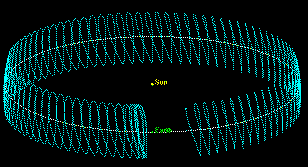I read Science News, both on paper and their electronic newsletter. The online newsletter has a section called MathTrek that's not included in the magazine, with fun math-based tidbits. This week, they talk about unusual orbits that have been calculated; they're possible, but unlikely to ever occur naturally. Charlie McDowell's animations are a good selection of interesting ones. I particularly like "8 on a Daisy". But I was surprised not to find any explicit mention of Cruithne (pronounced cru EEN ya) or 2002 AA2 9 there. Paul Doherty has a good discussion of Earth's Three Moons. (Wikipedia denies that Cruithne is a moon, but I couldn't find anything there that explained the distinction.)
While the orbits that Science News talks about are prettier, Cruithne and 2002 AA2 9 are real objects, and in some ways their orbits are even more bizarre. The mathematical constructs are (mostly) regular trefoils, flowers, and figure eights, and contain 4 to 99 bodies.  Cruithne and 2002 AA2 9 co-orbit with the Earth, and seem to have relatively stable orbits. Both travel at roughly the same distance from the sun as the Earth, with roughly the same period. They both follow a horshoe pattern from an Earth-centric perspective, travelling faster than the Earth till they almost catch up, then slowing down for many years until the Earth catches them, and they start the cycle again. Cruithne has a highly inclined orbit (20°) and is about 5 km in diameter. 2002 AA2 9 travels in a continuous spiral around Earth's orbit.
Cruithne and 2002 AA2 9 co-orbit with the Earth, and seem to have relatively stable orbits. Both travel at roughly the same distance from the sun as the Earth, with roughly the same period. They both follow a horshoe pattern from an Earth-centric perspective, travelling faster than the Earth till they almost catch up, then slowing down for many years until the Earth catches them, and they start the cycle again. Cruithne has a highly inclined orbit (20°) and is about 5 km in diameter. 2002 AA2 9 travels in a continuous spiral around Earth's orbit.
No comments:
Post a Comment